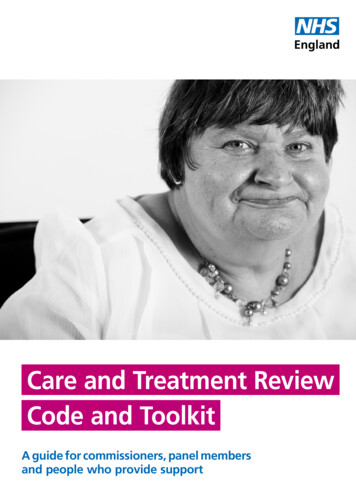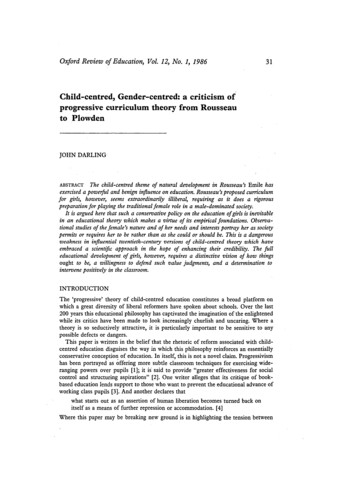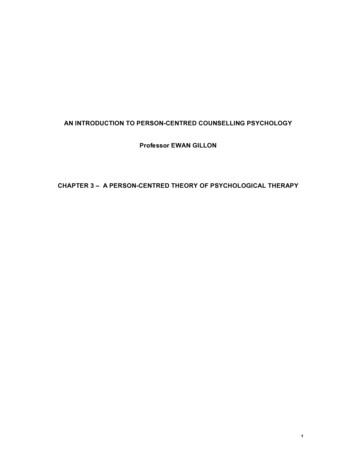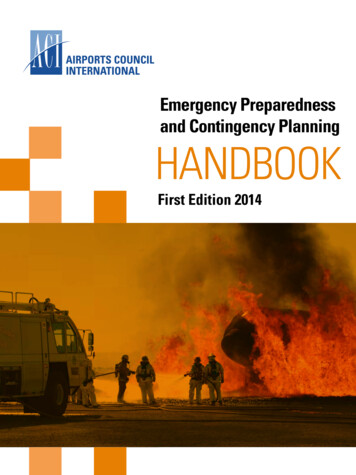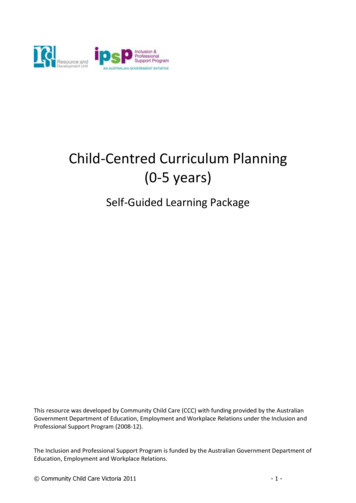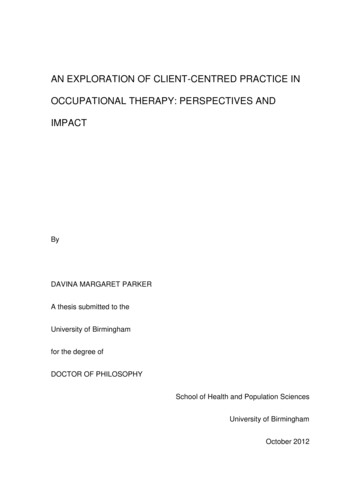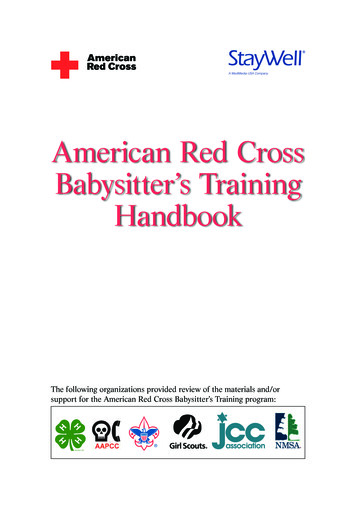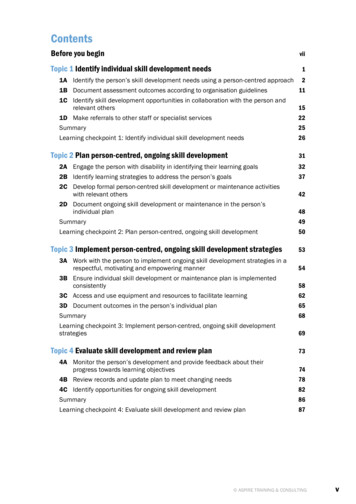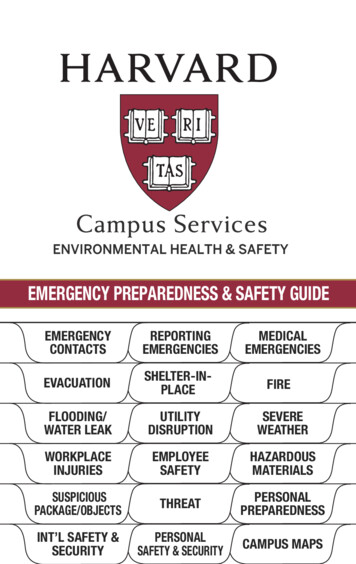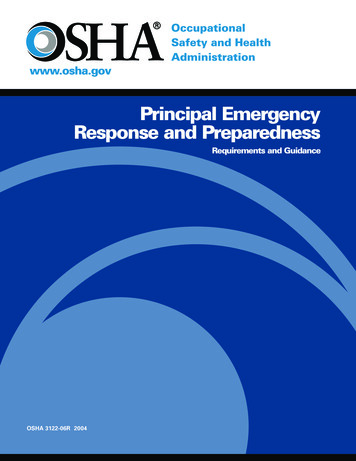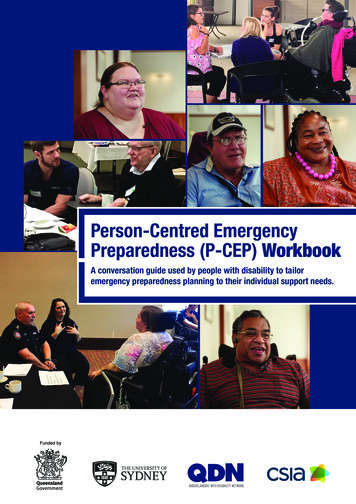
Transcription
Person-Centred EmergencyPreparedness (P-CEP) WorkbookA conversation guide used by people with disability to tailoremergency preparedness planning to their individual support needs.
This Person-Centred Emergency Preparedness (P-CEP)Workbook was co-designed with people with disability.It outlines four steps to increase emergency preparedness.It is helpful to think of these steps as a series of planning conversations.Each step provides information, resources, and guidance to get theemergency preparedness conversation started. Each planning conversationresults in self-assessment and actions to increase personal emergencypreparedness. People with disability can use this P-CEP Workbook to tailoremergency preparedness planning to their support needs – so they know howthey will act together with their support network in an emergency.Tailoring emergency preparedness to the needs of people with disabilitycan be supported by others who have knowledge, skills, and training inP-CEP planning conversations. Those people may be peer support leaders;community, health, or disability providers; or emergency services personnel.Peer Support Leaders trained in P-CEP Peer Support have already taken stepsto advance their own emergency preparedness plans. These peer leaders canhelp others to get prepared through peer support and mentoring.Funding: This project was proudly funded by the Queensland Government through the QueenslandDisaster Resilience Fund (QDRF) and the Department of Communities, Disability Services and Seniors,This project was led by the Centre for Disability Research and Policy at The University of Sydney inpartnership with the Queenslanders with Disability Network (QDN) and the Community Services IndustryAlliance (CSIA)Original illustrations of the P-CEP framework, Natural Hazards and Emergency Services by returnstudios.orgCitation: Villeneuve, M., Abson, L., Yen, I., & Moss, M. (2020). Person-Centred Emergency Preparedness(P-CEP) Workbook. Centre for Disability Research and Policy, The University of Sydney, NSW 2006ISSN: 2652-2241, Issue 2/No 1 (Online)
ContentsInvestigator Team . 04Development of the P-CEP Workbook . 05Preparedness is a Process Using the P-CEP Workbook Person-Centred Emergency Preparedness (P-CEP) Planning ConversationsGetting Started with Person-Centred Emergency Preparedness . 06Step 1Identify your strengths and support needs in everyday life . 10 Self-assess your strengths and recognise how you manage yoursupport needs every day.Step 2 Know your level of preparedness and learn about your disaster risk. 23 Your local hazard risk; Getting emergency information and alerts; Emergency service agencies and what they do; The role of government in emergency preparedness and disastermanagement; and Your responsibility before, during and after disasterStep 3 Make a plan for how you will manage your support needs in an emergency . 35 My Personal Emergency Preparedness Plan– Be Aware– Get Organised– Make it FitStep4 4StepCommunicate the plan with the people in your support network andaddress gaps through collaboration . 48Resources . 50Person-Centred Emergency Preparedness (P-CEP) WORKBOOK3
Investigator TeamPrincipal InvestigatorAssociate Professor Michelle VilleneuveCentre for Disability Research and PolicyThe University of Sydneymichelle.villeneuve@sydney.edu.auSteering CommitteeDiana Young, DirectorStrategy & Engagement Community RecoveryQueensland Department of Communities,Disability Services and SeniorsDiana.Young@communities.qld.gov.auMichelle Moss, Business and Operations ManagerQueenslanders with Disability Network (QDN)MMoss@qdn.org.auLouise Abson, Project OffcerQueenslanders with Disability Network (QDN)labson@qdn.org.auMatthew Gillett, General Manager ProgramsCommunity Services Industry Alliance (CSIA)mgillett@csialtd.com.auMelissa Dower, Manager, Industry ExcellenceCommunity Services Industry Alliance (CSIA)mdower@csialtd.com.auLaura Turner, DirectorReturn Studioscreative@returnstudios.orgResearch SupportIlan Ivory, Senior Communications StrategistThe University of SydneyIvy Yen, Senior Research AssistantThe University of SydneyCresta Markovic, Research AssistantThe University of SydneyQueenslanders with Disability Network (QDN)Peer LeadersRebecca BellisDonna BestBev BestWarwick BestNadia BradySharon BoyceRob EllisPeter GurrCharmaine IdrisEsperance KalonjiLisa MahonyWayne MaitlandGary MatthewsRachel MatthewsMatt McCrackenWilfred PrinceWill ProctorMarion RowleyDes RyanDavid SwiftPeter TullyAdvisory CommitteeAged and Disability Advocacy AustraliaAmparo Advocacy Inc.Australian Red CrossCommunity Services Industry AllianceDepartment of Communities, Disability Services and SeniorsLocal Government Association of QueenslandMoreton Bay Regional CouncilNational Disability Insurance AgencyNational Disability ServicesOffce of the Inspector-General Emergency ManagementQueensland HealthQueensland Alliance for Mental HealthQueensland Council of Social ServiceQueensland Disability Advisory CouncilQueensland Family and Communities AssociationQueensland Fire and Emergency ServicesQueensland Police ServiceQueensland Reconstruction AuthorityRedland Regional CouncilAcknowledgementWe are grateful to all of the Queenslanders with Disability Network (QDN) Peer Leaders whose insights gaveshape to this Workbook. We are especially indebted to Nadia Brady, Charmaine Idris and Peter Tully for theircontributions and detailed reviews; Ricky Buchanan, Bedridden Disability Advocate who put these P-CEP stepsinto actions that worked; Tara Collyer and Carol Nicol who contributed lived experience of disability and disastermanagement to support QDN Peer Leaders to develop their preparedness plans. Numerous emergency servicespersonnel applied their experience and expertise to co-design Step 2 of this Workbook – We thank QueenslandFire and Emergency Services (QFES), Fire and Rescue NSW, and Country Fire Authority Victoria.4Person-Centred Emergency Preparedness (P-CEP) WORKBOOK
Development of the P-CEP WorkbookThe Person-Centred Emergency Preparedness (P-CEP) Workbook is part of a growing suite of tools developed toenable people with disability to make emergency preparedness plans that are tailored to their individual supportneeds. A series of videos provide illustration of P-CEP in action.We developed this Workbook through a co-design process including Queenslanders with Disability Network(QDN) Peer Leaders, disability advocates, and emergency management personnel from agencies in Queensland,NSW and Victoria. It was feld tested with 25 people with disability.This Workbook is part of an ongoing project to develop a P-CEP Peer Leadership Program. The following fgureprovides an overview of the co-design methodology which integrated knowledge creation with knowledgeapplication (Graham et al., 2006).MethodologyMonitor & Evaluate:Tailor & Implement:Integrate P-CEP andPeer LeadershipApproachKnowledge to Action CyclePersonal emergency preparednesstailored to support needsRefne:P-CEP PeerSupport& MentoringKey Features of SuccessSupport & ResourcesSelect Approach:Peer SupportCapacityDevelopmentP-CEP WorkbookFacilitation GuideVideoInfographicsSustain:Identify paredness throughtailored planningThe collection of P-CEP tools and resources can be found entred Emergency Preparedness (P-CEP) WORKBOOK5
Preparedness is a process, not a one-time event!Emergency preparedness means taking steps to makesure you are safe before, during or after a naturalhazard or other emergency (e.g., house fre; pandemic).Some people with disability need tailored emergencypreparedness plans that take into consideration how theywill manage their unique support needs in emergencies.Personal preparedness is the most important thing anyone can do to make sure they are safe in an emergency.Being prepared helps people to respond better and recover faster. We all need to be ready and know what todo. The Disaster Risk Management cycle has four phases: prevention, preparedness, response, recovery. Thereare actions that people with disability can take to increase their resilience to disaster in each phase.Actions people with disability can takeSteps you take to identify disaster risk andincrease resilience, including: being aware of natural hazard events in yourcommunity and the places where you spendtime to understand your local hazard risk; learning about natural hazards and their impacton people and services self-assessing your preparedness, capabilitiesand support needs in emergencies; protecting your home to prevent or reducedamage from natural hazards.Steps you take to make sure you are safe before, duringand after a natural hazard or other emergency.This requires you to plan and act together with yoursupport network to protect against, quickly respond toand recover from emergencies. consider how you will manage during loss of essentialservices (e.g., water, power, transportation, food supply)and supports (e.g., community-based disability supportservices, home nursing, personal care) that you rely onevery day; use tools from the DIDRR Resource Library to makea plan.Preparedness is a process, not a one-timeevent. This means that your plan should bereviewed, updated, and communicatedregularly with your supportnetwork.RESILIENCEThe process of adapting to theimpact of disaster and the impact ithas on your home and community by: managing disruptions to critical servicesand the supports that you rely on; asking for or coordinating help from others; taking care of your health and well-being; caring for others in your family or community.6Person-Centred Emergency Preparedness (P-CEP) WORKBOOKActions you take to make sure you and thepeople you care about are safe in an emergency: be aware of your risk; heed disaster warnings; make decisions to shelter-in-place, evacuate to aplace of safety, or take refuge; implement your preparedness plan together with yoursupport network; look out for your family, friends and neighbours –making sure that they have information and are safeduring a disaster.
FACT: People with disability manage every dayin environments that are often inaccessible. Theydevelop their own strategies for using their strengthsand managing their support needs in ways that workfor them. They regularly adapt to changing situations.These are strengths that people with disability bringto emergency preparedness.Disability Inclusive Disaster Risk Reduction (DIDRR) means making sure the needs and voices of peoplewith disability are included in how governments and emergency service agencies to plan for and managedisaster risk.The Queensland DIDRR Framework provides steps that different stakeholders can take to increase theresilience of people with disability to disaster.Disability inclusive& Disaster-resilientQueenslandDisability-Inclusive Disaster Risk Reduction(DIDRR) Framework and ToolkitThe Queensland DIDRR Framework and Toolkit can be accessed at: www.collaborating4inclusion.orgOne important part of the DIDRR Framework focuses on actions that people with disability need to take inorder to increase their personal emergency preparedness. That is the focus of this P-CEP Workbook.Person-Centred Emergency Preparedness (P-CEP) WORKBOOK7
Using this P-CEP WorkbookHaving an emergency preparedness plan means knowing how you will act together with your support networkbefore, during, and after a disaster.By using this workbook, you can create a realistic plan.A realistic emergency plan considers: your individual strengths, support needs, and situation; steps you have already taken to prepare; gaps in your preparedness that increase your risk in emergencies; and ways to address the gaps.This Workbook helps you take steps to increase your personal emergency preparedness. Prompts and tipshelp you to get started by considering your current stage of preparedness and helping you get to the next level.Spaces are provided to document your learning, refections, and action plans.Information about emergency services and disaster warnings is provided to: learn about local hazard risk, be aware of disaster warnings, know where to go for information; and make good decisions before, during, and after a disaster.Person-Centred Emergency Preparedness PlanningConversationsPlanning conversations start with you and your support network (e.g., family, friends, peers) talking about whatyou need to be safe before, during, and after an emergency.Your job is to make a plan for how you will act together with your support network in emergency situations.The Person-Centred Emergency Preparedness (P-CEP) framework helps you to think about your strengths andsupport needs in these eight areas:what I dowhere I do itwho I do it withPerson-Centred Emergency Preparedness (P-CEP) Capability WheelPublished with permission (www.collaborating4inclusion.org)8Person-Centred Emergency Preparedness (P-CEP) WORKBOOK
Getting StartedThis workbook breaks P-CEP planning down into four action steps.Think of each step as a planning conversation.These four actions are not going to happen in one day.Work through the P-CEP at your own pace.Action steps to increase emergency preparedness.StepActions1Identify your strengths and support needs ineveryday life2Know your level of emergency preparedness andlearn about your disaster risk3Plan for how you will manage your support needs inan emergency4Communicate the plan with the people in your supportnetwork and address gaps through collaborationSupport from others is important.You should reach out to others in yourcommunity to get the information andsupport you need.Person-Centred Emergency Preparedness (P-CEP) WORKBOOK9
1Identify your strengths and support needs in everyday lifeKnowing how you manage every day is the frst step in planning for how you will manage in anemergency. In this step, think about what your support needs are in your day to day life, not inan emergency.This will help you with your emergency planning when you get to Step 3.First, think about what you do; where you do it; and who you do it with.Think about your roles and responsibilities in everyday life.For example, your schedule might include:Work/volunteering commitmentsMeetingsGym/exerciseScheduled social engagementsSupport worker scheduleTherapy appointmentsMedicationOther family members leaving for work and coming homeA typical day for me looks like this:Notes:10Person-Centred Emergency Preparedness (P-CEP) WORKBOOK
Next, use the Person-Centred Emergency Preparedness Framework or “Capability Wheel” tothink about your strengths and discuss how you manage your support needs every day.Start where you like and go around the Capability Wheel.1Focus on the elements that are relevant and skip the ones that do not applyto you.Consider how you manage your support needs every day. Think about:– What do you do for yourself?– What do you rely on others for?On the following pages, defnitions are provided for each area of the Capability Wheel.Prompts are used to guide self-refection.Spaces are provided to write down your ideas.what I dowhere I do itwho I do it withPerson-Centred Emergency Preparedness (P-CEP) Capability WheelPublished with permission (www.collaborating4inclusion.org)We call it the “Capability Wheel”because capabilities include what youdo for yourself, what you need supportfor, and how you get the support youneed. Together these make up yourcapabilities.Person-Centred Emergency Preparedness (P-CEP) WORKBOOK11
1CommunicationGetting, giving and understanding information.It includes the use of *Augmentative and AlternativeCommunication (AAC)1. It is also the means of sending orreceiving information such as telephone (landline; mobile) orcomputers.Consider: What support do I need for seeing, hearing,speaking, understanding?Notes: What assistive devices, tools, technologies,or services do I rely on to communicate? How do I best communicate? (e.g. Auslan,written communication, Braille etc.) How do I usually go about gettinginformation? Things that help me talk? (e.g.communication system, gestures, pictures,people, etc) Things that help me understand? (e.g.,pictures, simple words, showing me, etc) What support do I need to call people or getinformation from others? (e.g., Landline,mobile, computer, other device) Who/what sources do I trust to give mehelpful information? Do I have access to a computer/internet/data?112* AAC are communication methods used to supplement or replace speech or writing for those with impairments in the production orcomprehension of spoken or written language.Person-Centred Emergency Preparedness (P-CEP) WORKBOOK
1Management of HealthTaking care of your health.The medical management of your condition which may includemedicines, nutritional, exercise, health or other treatments ortherapies that help you to maintain your well-being. This alsoincludes how you look after your mental health.Medical management includes management of wounds,catheters or ostomies; access to medical supplies, equipmentor their maintenance; operating power-dependent equipmentto sustain life.Consider: Where do I keep my health information?(e.g., identifcation, Medicare, health records)Notes: What are my health conditions/exercise/nutrition needs? How do I manage and monitor my health/medical/treatment? What power sources are needed to operatemy medical equipment (e.g., battery,electricity) ? Who helps me? Where do I get my supplies? How do I manage my supplies? What treatments/therapies are important formy physical health, my mental health andwell-being? Do I have private health insurance? Whatservices are covered by my insurance? Who is my doctor? What other healthprofessionals or services do I rely on? Who is my local chemist?Person-Centred Emergency Preparedness (P-CEP) WORKBOOK13
1Assistive TechnologyThe help you get from equipment.Assistive technology is any device, system or design, thatallows you to perform a task that you would otherwise beunable to do. Assistive technology can increase safety or maketasks easier to do. It can include anything (e.g., tool or device;high or low tech) that assists you to carry-out your dailyactivities.Consider:Notes: What assistive devices, technology, orequipment do I use? What supplies do I always have on hand? What power sources are needed to operatemy equipment? What is required to maintain the equipment? Who helps me?My List of EquipmentCritical to my functioning?YES14NOPerson-Centred Emergency Preparedness (P-CEP) WORKBOOKUse, Maintenance or RepairConsiderations
1Personal SupportHelp you get from other people every day.The assistance received from another person for personal careor support with activities of daily living. It can include bothpractical and emotional support that enables you to do thethings you want, need or have to do every day.Consider: Who helps me with my self-care/activities ofdaily living?Notes: What do they help with? When do they help? How do I organise my personal care? How do I manage if/when they areunavailable?My Service ProvidersService Provider Nameand RoleOrganisationthey work forPhoneNumberAddress orEmailPerson-Centred Emergency Preparedness (P-CEP) WORKBOOK15
1YesMake notes about the help you ngCleaningShopping/GroceriesManagingequipmentHouse KeepingHomeMaintenance16Person-Centred Emergency Preparedness (P-CEP) WORKBOOK
1Assistance Animals, Pets & Companion AnimalsHelp from animals. How you care for them.Assistance animals provide an important service that helpssome people to more fully participate in personal and publiclife activities with more confdence and independence (e.g.,mobility guide; hearing assistance; diabetic, seizure alert orresponse; emotional support, etc.).Pets and companion animals are very important to manypeople.Consider:Notes:Information What type of animal/s or pet/s do I have?What is my animals/s or pet/s name/s? Where do I keep my animal’s information,medications, insurance? Do I have collar, ID Tag, and leash for myanimal? Evidence of my animal’s registration,desexing and vaccinations? Contact details for my Vet?Supplies What care does my animal need? Who helpsme to provide that care? Where do I get supplies for my animal?Eating, Sleeping, Cleaning What food does my animal eat? What is important for my animal to sleep?(blankets, bedding, nesting) What is important for cleaning? (litter, tray,waste cleaning, bags) What is important for play? (toys, comfortobjects)Other information Key commands for my animal are? Others should be aware about?Person-Centred Emergency Preparedness (P-CEP) WORKBOOK17
1TransportationHow you travel to where you want to go (e.g., car,bus, train, taxi, walking).How you get around from one location to another andincludes independent travel and travel with others (e.g.,family, support worker), including assistance animals and pets.Consider:Notes: Where do I need to go? (e.g., work, leisure,volunteering, shopping, etc) How do I get to places in the community? Who helps me? Who drives? How do I organise my transportation?Me/My Service ProvidersName of Driver18PhoneNumberDriver LicensenumberPerson-Centred Emergency Preparedness (P-CEP) WORKBOOKCarRegistration
1Living SituationWhere you live and who you live with.Where you live and the context of your home situationincluding who you live with, the type of building, how longyou have lived there, the accessibility, safety, security, andadequacy of the physical environment, and the location.Consider:Notes: Who do I live with? Where do I spend most of my time when I’mat home? How does the location of my home (city,town, rural) affect how I go about my dailyactivities? Things that make me feel safe/unsafe at myhome or in my community? What is my water, electricity, gas supply? How many exits are there? Are theyaccessible? Is there a lift? Do I have functioning smoke alarms? Whenwere they last checked?My Important ServicesCompanyAccount NumberContact tsInsurancePerson-Centred Emergency Preparedness (P-CEP) WORKBOOK19
1Social ConnectednessThe people you do things with.Your relationships with friends, family andother people. Help you give to other people.The relationships between you and the people in yourcommunity. These relationships may be personal (e.g., family,friend, neighbour) and/or professional (e.g., service provider,community leader).Consider:Notes: Who is in my circles of support? Who do I count on? What type of support do they give me? Who counts on me? What type of support do I give them? What is the nature of my relationships withothers? (e.g., How long have I known them?; How often do we see each other?; Do theylive near or far? Direction of support – Ihelp them, they help me, both; closeness/connectedness (emotional); Am I/theyjudgemental or disapproving? Am I/theysupportive or encouraging?) Where can I go if I ever need support ora place to stay? Have I spoken to themabout this?My main support peopleName20PhoneAddressPerson-Centred Emergency Preparedness (P-CEP) WORKBOOKNotes
My Support NetworkWrite down the people in your life and think about your connection with them. Who do you relyon? Who relies on you? Do they live nearby or far away? How do you stay in contact?My connections in the widercommunity where I spend my time(e.g., shopping, restaurants, publictransportation, library, etc)My connections with professionals (e.g.,service providers, community leaders)My connections through regular activities such as:work, school, volunteering, religious affliation, clubs,community groups, ftness, peer support and otheractivities (e.g., online activities).My connections with family, carers,housemates, peers, and neighboursPerson-Centred Emergency Preparedness (P-CEP) WORKBOOK211
1Document the key people you can rely on. Identify who can and whocannot provide support when you need help. Identify people you providesupport for.22Person-Centred Emergency Preparedness (P-CEP) WORKBOOK
2Know your level of preparedness and learn about yourdisaster riskHow prepared are you for emergencies?Where are you on this diagram?1Haven’tthoughtabout it234Thoughtabout it butnot yet actedStartedto getorganisedHave takenactions toget ready5Reviewedactions andtold othersSome of us are further along on our emergency preparedness than others. Let’s face it, if youhaven’t thought much about preparedness, it would be unfair to expect you to achieve level 4or 5.It takes time to learn about your risks and take preparedness steps.Emergency preparedness is a process.The goal is to increase your emergency preparedness incrementally.You can start by identifying priority areas and taking small steps.Start with what you can do today.“Only a few people with disability that we spoke to had taken stepsto tailor emergency preparedness to their support needs such as:documenting instructions for support workers in an emergency,holding household emergency meetings, and planning evacuationroutes.For the people who engaged in it, disability-specifc planninggave them confdence that they would be able to manage in anemergency.”Person-Centred Emergency Preparedness (P-CEP) WORKBOOK23
2Examples of Stage of PreparednessElspethPaulElspeth lives with her partner who works.Elspeth cannot walk long distances and walksusing 2 crutches, callipers and orthotic shoes.Elspeth also experiences incontinence andhigh blood pressure. Elspeth thought aboutother equipment that she will need if she wasevacuated such as: portable shower benchthat can be folded, commode chair, changingtent. Elspeth has a bag with basic emergencyinformation and a memory stick with importantinformation on it. Elspeth has applied for amanual wheelchair at her last NDIS reviewmeeting.Paul has degenerative MS. He receivesapproximately 75 hours of assistance fromsupport workers during the weekdays. Paullives with his wife, who experiences mentalhealth issues. Paul uses a wheelchair daily andhas another 2 spare chairs that are constantlycharged. In the event of a loss of services, Paulhas a 1 month supply of medication at home.Paul has the emergency numbers for his localarea on the fridge. Paul also has TV dinnersstored in his freezer. Paul’s support workerlives nearby. They agreed to take Paul and hiswife to their home and/or stay at Paul’s home,depending on the disaster. The support workerhas a generator. Paul also has a large generator.Paul has spoken to his neighbour who hasagreed to get fuel for the generator.Personal Preparedness:Elspeth has thought about what to do and hassome supplies.X1234Personal Preparedness:Paul has discussed his emergency preparednessplan with his support workers amd neighbourwith clear actions.5XAisha1As a young adult, Aisha experienced a strokethat affected the left side of her body. Aisha islegally blind with partial amputation in both legs.Aisha and her husband recently moved into anew 60-unit complex. In relation to their livingsituation, they reviewed the geographical risksin the area before deciding to move in. Aishahas spoken to her property manager aboutemergency evacuation for tenants because sheidentifed that in the event of loss of power, theemergency doors will be diffcult to open.124234345WalterWalter lives on his own. He receives 24 hourssupport on a rotating roster with a team of 5support workers. Walter’s family live close tohim and provide support. Walter runs a localcoffee delivery business in the community.Walter uses google home to turn on the lightsand TV in his home. Walter acknowledged thathe needs to think about how he will manage ifthere was a loss of power supply in his home.Personal Preparedness:Aisha she has taken action to addressemergency evacuation in her new unit.X2Personal Preparedness:Walter has not taken any preparatory actions.5XPerson-Centred Emergency Preparedness (P-CEP) WORKBOOK12345
2Learn about your disaster risk and the emergency management arrangementsin your community5.yourresponsibilitybefore, duringand afterdisaster4.the role ofgovernmentin emergencypreparednessand disastermanagementPersonal emergencypreparedness can bestrengthened whenyou understand:1.your localhazard risk2.where to getemergencyinformation andalerts3.whatemergencyserviceagencies do1. Understanding Local Hazard RisksYou can make a better Plan when you understand what to expect in an emergency.A good place to start is by learning about the local hazard risks in your community.Visit your local council website to learn about the local hazard risks where you live.If you do not have internet access, you can call and talk to someone at your local council toask about the hazard risks where you live, work, and spend time.Person-Centred Emergency Preparedness (P-CEP) WORKBOOK25
2My emergency risks:What are the main risks in yourcommunity?(check ones that apply)How would the emergency affect amiLandslideHouse frePower outageHealth emergency(e.g., like COVID-19pandemic)You can learn more about the different types of local hazards and how to prepare for them. Usethe information guides and links provided below to plan to protec
services, home nursing, personal care) that you rely on every day; use tools from the DIDRR Resource Library to make a plan. Preparedness is a process, not a one-time event. This means that your plan should be reviewed, updated, and communicated regularly
